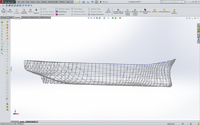Introduction: Trumpeter USS Missouri BB-63, 1945 fit in 1/200 scale
Prototype At-a-Glance |
|---|
| Career | Specifications | Armament |
|---|
| Type: | Battleship | | Displacement: | 45,000 tons | | Armor: | 12-19in |
|---|
| Nationality: | USA | | Length: | 887ft 2in | | Main gun: | 9 × 16in/50cal Mk7 |
|---|
| Manufactured: | Brooklyn Navy Yard | | Beam: | 108ft 2in | | | 20 x 5in/38cal Mk12 |
|---|
| Designed: | 1938 | | Draft: | 28ft 10in | | Secondary gun: | 80 x 40mm/56cal AA |
|---|
| Manufactured: | 1941-1944 | | Crew: | 2,700 | | | 49 x 20mm/70cal AA |
|---|
| Number built: | 1 | | Speed: | 33kts | | Main plant: | 212,000 shp |
|---|
| Homeport: | various | | Range: | 14,890mi | | | |
|---|
WikiPedia link
Use the Section Menu at left to navigate these USS Missouri pages: use the vertical scroll bar as needed to view each page in its entirety.
When Trumpeter announced the impending release of a 1/200 Iowa battleship, it was much like when HK Models announced a 1/32 B-17G - the fulfillment of a childhood dream.
Finally the opportunity to build a large(r) scale model. I immediately reserved my copy from Freetime Hobbies. I have to take a momnet and note that Brandon (Freetime owner)
actually made the effort to travel to the port of delivery for his batch of kits so that he could personally ensure they were turned around and quickly shipped to his customers:
very cool service.
As documented elsewhere, there are some "issues" with the shape of the hull on this (and other) Trumpeter kit. Not being one who easily settles, I committed to coming
up with a solution to this problem. I started by modeling the Iowa hull in Solidworks, based on drawings I had obtained from The Floating Drydock.
Admittedly this drawing set does not cite original source material, but the shape is very persuasive when modeled in 3D. The image below shows a very early set of hull stations
- which are spaced at 21.5 feet - in 1/200 scale (click image to see larger version).

I next took careful measurements of the trumpeter kit's hull and overlaid these onto the 3D model. The result simply confirmed what was already known - the kit hull is
dramatically incorrect in the after third below the waterline. The outline of the kit hull at the sheer, however, was virtually identical to the drawing-based 3D model - well
within the margin of measurement error.
Having completed this analysis, an idea began to percolate. Since I have access to a high-quality, relatively large (accuracy: > 0.007", 10x10x10" maximum part size)
3D printer, this seemed like a great application of technology to solve a problem. I decided to replace the after 18-inches of the (52-inch) hull with a section printed in ABS.
Since this part would be larger than the printer can print, I would have to break it into two sections.
I should mention that prior to this exercise I had never touched Solidworks, so much of the time spent in the design phase was actually me coming up the learning curve.
The relative difficulty associated with this curve was dramatically compounded by the fact that my first modeled subject was something so complex as a ship's hull.
This section documents progress on my 1/200 Missouri, starting with creation and installation of my "hull correction kit."